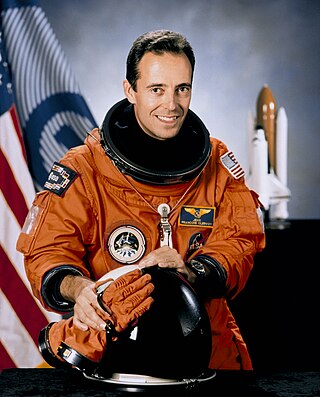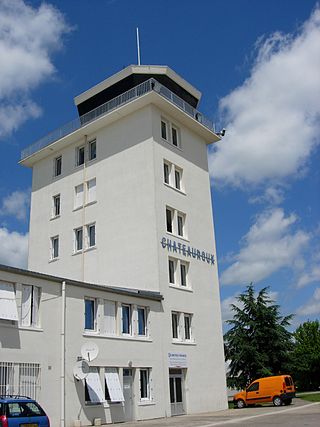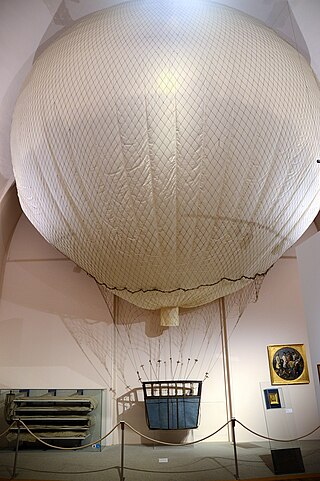
Concorde is a retired Anglo-French supersonic airliner jointly developed and manufactured by Sud Aviation and the British Aircraft Corporation (BAC). Studies started in 1954, and France and the United Kingdom signed a treaty establishing the development project on 29 November 1962, as the programme cost was estimated at £70 million . Construction of the six prototypes began in February 1965, and the first flight took off from Toulouse on 2 March 1969. The market was predicted for 350 aircraft, and the manufacturers received up to 100 option orders from many major airlines. On 9 October 1975, it received its French Certificate of Airworthiness, and from the UK CAA on 5 December.

Jean-François André Clervoy is a French engineer and a CNES and ESA astronaut. He is a veteran of three NASA Space Shuttle missions.

Paris–Le Bourget Airport is an airport located within portions of the communes of Le Bourget, Bonneuil-en-France, Dugny and Gonesse, 6 NM north-northeast of Paris, France.

The Paris Air Show is a trade fair and air show held in odd years at Paris–Le Bourget Airport in France. Organized by the French aerospace industry's primary representative body, the Groupement des industries françaises aéronautiques et spatiales (GIFAS), it is the largest air show and aerospace-industry exhibition event in the world, measured by number of exhibitors and size of exhibit space, followed by UK's Farnborough Air Show, Dubai Air Show, and Singapore Airshow.

A test pilot is an aircraft pilot with additional training to fly and evaluate experimental, newly produced and modified aircraft with specific maneuvers, known as flight test techniques.

Major André Édouard Turcat was a French Air Force pilot and test pilot celebrated for flying the first prototype of Concorde for its maiden flight.

The Fairey Delta 2 or FD2 is a British supersonic research aircraft that was produced by the Fairey Aviation Company in response to a specification from the Ministry of Supply for a specialised aircraft for conducting investigations into flight and control at transonic and supersonic speeds. Features included a delta wing and a drooped nose. On 6 October 1954, the Delta 2 made its maiden flight, flown by Fairey test pilot Peter Twiss; two aircraft would be produced. The Delta 2 was the final aircraft to be produced by Fairey as an independent manufacturer.

The École de l'air et de l'espace is a military school and grande école training line officers in the French Air and Space Force. It is located at Salon-de-Provence Air Base in Salon-de-Provence, France.

A supersonic aircraft is an aircraft capable of supersonic flight, that is, flying faster than the speed of sound. Supersonic aircraft were developed in the second half of the twentieth century. Supersonic aircraft have been used for research and military purposes, but only two supersonic aircraft, the Tupolev Tu-144 and the Concorde, ever entered service for civil use as airliners. Fighter jets are the most common example of supersonic aircraft.

The Musée de l'air et de l'espace is a French aerospace museum, located at the south-eastern edge of Paris–Le Bourget Airport, north of Paris, and in the commune of Le Bourget. It was inaugurated in 1919 after a proposal by the celebrated aeronautics engineer Albert Caquot (1881–1976).

Châteauroux-Centre "Marcel Dassault" Airport, formerly known as Châteauroux-Déols "Marcel Dassault" Airport, is an airport serving the French city of Châteauroux. The airport is located 5.5 km (3.0 NM) north-northeast of Châteauroux in Déols, a commune of the Indre department in the Centre-Val de Loire region in France. The airport is named after Marcel Dassault and is located on the site of the former Châteauroux-Déols Air Base. It is dedicated to air freight, aeronautical maintenance, pilot training and training of airport firefighters.
A flight test engineer (FTE) is an engineer involved in the flight testing of prototype aircraft or aircraft systems.

Bernard Ziegler was a French pilot and engineer, who served in Airbus as senior vice president for engineering, well known for his evangelical zeal for the application of the fly-by-wire system in the Airbuses. He was the son of Airbus founder Henri Ziegler.
Constantin Wladimir Rozanoff, also known as Kostia Rozanoff, was a French test pilot, a colonel of the French Air Force, and one of the pioneers of jet aviation. He was the chief test pilot at Dassault Aviation. He flew 201 types of planes and helicopters while logging 5,000 flying hours, including 3,865 combat hours. He also broke the sound barrier 104 times.

Jean-Loup Jacques Marie Chrétien is a French retired Général de Brigade in the Armée de l'Air, and a former CNES spationaut. He flew on two Franco-Soviet space missions and a NASA Space Shuttle mission. Chrétien was the first Frenchman and the first western European in space.
Béatrice Vialle is a French aviator, one of the two operational female Concorde pilots and the first French female pilot on a supersonic airliner.
John Cochrane was a British test pilot for the Anglo-French supersonic airliner, Concorde.

Chalais-Meudon is an aeronautical research and development centre in Meudon, to the south-west of Paris. It was originally founded in 1793 in the nearby Château de Meudon and has played an important role in the development of French aviation.
Jean-Marie Saget was a French military pilot who later worked for Dassault Aviation as a test pilot from 1955 to 1989.














